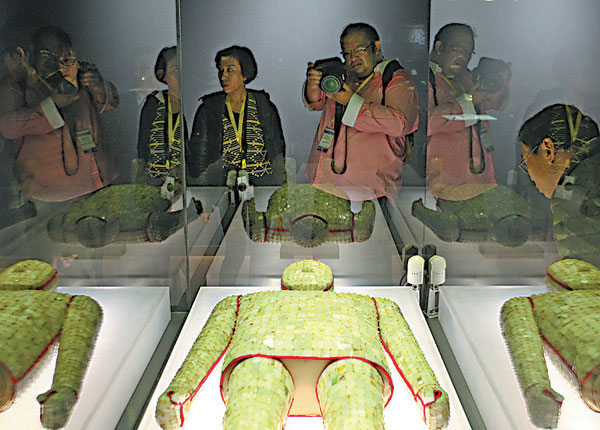Xuzhou Museum: life, brutal death and a luxurious afterlife
|
Journalists examine funerary suits tailored with thousands of jade tiles sewn with metal thread at the Xuzhou Museum. |
The Xuzhou Museum deals with the luxuries of life - and the homicidal contraptions devised to force its violent conclusion.
It's fitting that the first floor is devoted to war.
The 2,600-year-old settlement of Xuzhou withstood more than 200 battles throughout imperial times as Jiangsu province's oldest city.
Yet weapons found in the area hark as far back as the Neolithic age, when bamboo bored holes into stone axes. Next to the blades of rock is a replica of a human femur that sports an arrowhead.
The display shows why armor was developed. Other exhibits at the museum show how.
A 10-kilogram suit of Han Dynasty (206 BC-AD 220) iron armor consists of 2,000 plates. Statues of a Song Dynasty (AD 420-479) horse and general sport armor from their era. Displays of Yuan Dynasty (1271-1368) breastplates show how chain mail's agility gave the Mongolian civilization's military advantage - agile horsemanship.
Visitors can lift the sleeves of replica chain mail to feel its hidden heft.
The ornate spears of the Han generals were purely ceremonial - nothing you'd bring to actual combat. But many weapons used for the actual dirty work of spilling blood and guts were grisly, rather than pretty.
Take shields beset with spikes in the center and angry hooks clawing from the top and bottom. Or curved blades with long handles designed to separate charging horses from their hooves. A crossbow from the era could kill from 80 meters.
A hunk of encased earth from Ming Dynasty (1368-1644) weaponry is a honeycomb of crusty helmets.
Cherry bombs, it appears, are nearly as old as gunpowder and are displayed with bronze gun barrels among the first firearms. A Qing Dynasty (1644-1911) cannon and cannonballs are also displayed nearby.
While the first floor is devoted to death on the battlefield, the other two focus on life - well, mostly the afterlife, where you go if you die in battle, or from any other cause.
Most of the displays on the second and third floors - respectively devoted to jade and pottery - are funerary. There are two actual tombs behind the main hall.
The jade is mostly extracted from local kings' tombs found in Shizi Mountain in 1995.
Rulers were also buried with jade dragons and engraved discs used in worship. The shape is meant to emulate heaven. (Earth is square according to Chinese geomancy.)
The most striking displays are of the funerary suits tailored with thousands of jade tiles sewn with metal thread.
While an unidentified king's suit was stripped of its 1.58 kg of gold by grave robbers, the tomb raiders dared not take even one of the 4,248 tiles, since the precious stone's ownership was the sole realm of nobility.
Possession by anyone else was a capital offense. So there was no black market.
Other jade suits sewn with silver and copper belonged to a general and prince. They encased every inch of the cadaver aside from a hole at the top of the head - a portal for the soul to whoosh in and out as it pleased.
Jade, crystal and glass cicadas were placed in the mouths of the dead elite to facilitate rebirth, since cicadas erupt from the earth after dormancy. The Han plugged pretty much every hole in the face.
The pottery floor proves emperors didn't buy into the idea: "You can't take it all with you."
Han emperors abandoned the practice of sacrificing their servants to be interred with them. They were instead entombed with individualized clay likenesses of their courts. There are clay concubines for afterworld romps.
Prince Chu's tomb hosted a musical ensemble with musicians and maidens.
Rows of officials tend to the boring aspects of administration in the afterlife. And there are soldiers, generals and horses in case war breaks out in the spirit world.
Visitors can see where the Tushan king's family spent that afterlife, by visiting their first-century AD tombs.
While the Western Han built mausoleums inside mountains, the Eastern Han built mountains around mausoleums. Pottery, bronze coins and 4,000 clay seals were discovered in the rammed earth piled 17 meters over the graves.
Visitors can see the queen's jade bodysuit in her burial chamber. It seems she indeed enjoyed the finer things in life-even after it was over.
(China Daily 12/07/2015 page7)















